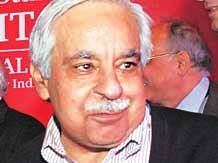 Within a week of the Telecom Regulatory Authority of India giving its final recommendations on the valuation and pricing of spectrum, Chairman Rahul Khullar speaks to Business Standard on the process the regulator followed in finalising the much-debated issue.
Within a week of the Telecom Regulatory Authority of India giving its final recommendations on the valuation and pricing of spectrum, Chairman Rahul Khullar speaks to Business Standard on the process the regulator followed in finalising the much-debated issue.
Edited excerpts:
How did you arrive at the conclusion that spectrum prices needed to be cut substantially for future auctions? There had been a lot of discussion alleging the country had lost thousands of crores of rupees to wrong pricing.
We were conscious of the fact that the previous two auctions had failed.
We needed to solve the problem and that was not possible if we stuck to the earlier methods.
The earlier approach (based on 3G spectrum auction in 2010) was to arrive at a pan-Indian valuation, as allocations had to be made across all 22 telecom zones.
A similar process was used in 2012: Indexing the 3G price for inflation and sectoral efficiency.
This had two issues.
First, there was a rule-of-thumb allocation from the pan-Indian level to an LSA (licensed service agreement) level.
Second, it distorted relative prices, that is, this approach did not factor in market conditions -- the LSA-specific factors.
This time, we decided to take a different approach.
Rather than going for the top-down approach, we opted for a bottom-up one.
We tried to find the valuation of spectrum for each of the 22 telecom zones.
The value of spectrum is determined on market information, technical factors and economic factors.
We came up with five or six different methods, such as econometric regression, production function, opportunity cost model, etc.
Each method gives a different valuation -- some low and some high.
In the 1,800-MHz band, even incumbent operators have bought spectrum through auction in 14 telecom zones.
So, this can be taken as a sort of market price or market information.
All that the regulator has done is that it has followed scientific methods, using market information as revealed in the previous auctions, to derive prices. This is how we determine valuation.
The next decision was that reserve price should be 80 per cent of the valuation of the spectrum. The rationale for this was provided in the recommendations.
Didn’t Trai follow scientific methods earlier?
Scientific methods vary from time to time.
The method we have used is different from earlier ones.
It is not about the method; rather, it is about how we ‘solved’ the problem.
The authority has tried to make an objective assessment, based on the average of just a few possible alternatives.
Valuations are arrived by a few methods. There can be hundreds of alternatives.
We can’t consider all of these, as it would take 20 years to reach a conclusion.
We had to complete the process in just eight weeks.
Also, we had offered all these methods to stakeholders of the industry for their comments.
We also asked them to give more alternatives, if they did not like any.
But, nobody has given us any workable one. Hence, we went ahead with what we had.
With the extended GSM band, CDMA operators say they will have no growth path in 800 MHz . Yet, you recommend the extended GSM band to be auctioned?
What the Authority has said is that in the 800 MHz band, any operator doing voice has enough spectrum to cater to its users, and everybody know this.
CDMA operators with 5 MHz or 3.75 MHz of airwaves in the 800 MHz band are more than adequately capable of dealing with their customers.
In fact, one of the CDMA operators has already volunteered to surrender its spectrum in the 800 MHz band.
Our approach was that we need to realise the opportunity cost of 800 MHz spectrum.
If the spectrum in this band can be used in creating the extended GSM band, the value of the same spectrum would be three to four times that of the existing value of the 800 MHz band.
With the recommendations, we can with very little changes make 2x5 MHz of spectrum available for almost all LSAs, once the spectrum in the extended GSM band becomes available for all operators.
The point is that we should not sell spectrum in the 800 MHz band when there is an opportunity to enhance its value without dislocating any 800 MHz band operator in any way.
In most circles, 15-17 MHz is available in the 900 MHz band, and if we can add 10 MHz more through the EGSM band, there will be opportunity for more than three operators (as it is now), and there can be four players, giving everybody an opportunity to bid for it.
In any case, as there is no reservation for the 900 MHz band, though operators wanted it then, why should there be any reservation for the 800 MHz band? How could that be justified?
You have now come up with a uniform three per cent charge for spectrum usage. How is that justified and what could be the possible impact? Many say this is a way to offer a huge financial bonanza to the incumbent operators.
Ideally there should not be any SUC (or very low charge) at all but that would have revenue implication.
At present, there we have a bizarre scheme that stipulates different rates for different spectrum bands and technologies that the operator uses.
What the authority has said is that for anybody who buys spectrum in an auction, the charge should be a flat rate of not more than three per cent.
The current system bars anybody from acquiring spectrum.
As in the consultation paper, no merger or acquisitions are discouraged because the charges rise because of bracket creep-up as you get more spectrum.
The authority has also recommended that when an operator buys spectrum in an auction. that should not be added to its existing stock to calculate the spectrum usage charges.
So, the disincentive against spectrum acquisition is resolved.
The BWA (broadband wireless access) spectrum was primarily for ISP (internet service providers) and broadband operators, and was at one per cent SUC.
Now, they can also do voice, so we will have a level field for all operators.
This is why we recommended three per cent SUC for BWA spectrum.
We also recommended that all spectrum, regardless of bands, should be tradable and all operators should have same rollout conditions.
The only thing beside this is for everyone else, we have suggested the spectrum usage charges be capped at five per cent with effect from April 2014.
Some operators might pay more than five per cent but the impact will be minimal.
Not the Rs 70,000-crore (Rs 700-billion) bonanza that some have alleged the Trai has given operators.
Some operators which bid and won spectrum in November 2012 are now saying the government should refund the money, as they have paid much more compared to the new recommended revised price. How will you deal with this issue?
For 14 telecom circles, there was a voluntary bidder in the November 2012 auction.
Four circles did not receive any bid in the previous auctions.
The so-called problem is confined to four circles -- Kolkata, Andhra Pradesh, Gujarat and Tamil Nadu -- where there is a reserve price lower than the November 2012 base price.
But the market price is yet to be determined. Why should there be any refund?
Operators have been raising their tariffs over the past few months. How would Trai address the issue? Should forbearance policy come under scrutiny?
While operators have increased rates, the headline one has been at Rs 1, which we had accepted earlier.
The actual realisation is much lower, as all the operators offer a lot of freebies.
What most operators have been doing is that they have been calling back the freebies over a period of time, essentially because of the pressure on margin.
A couple of operators have also raised the headline rate but, again, they offer more freebies.
Realistically, the increase in realisation is about two-three paise a minute per quarter.
Over a year, this would be eight-nine paise.
To reach Re 1 might take five years. If the operators increase the headline rate more than Rs 1, then the regulator might intervene.
What has happened now is that operators have offered at very low rates, and customers have got used to it but this cannot continue and consumers need to understand that.
You have come under questioning on the 12-minute cap on advertisements. The broadcasting sector is divided, with news broadcasters saying it will kill them but entertainment channels say it is the right way.
Across the world, there are restrictions and limits on how much advertising can be aired. And, these time restrictions are honoured.
In most countries, business models are being adjusted to comply with statutory rules and regulations. Here some broadcasters are saying, change your rule and regulations to suit our business model.
On the other hand, broadcasters have asked me why content shouldn’t be priced freely.
There is a history here and this is a matter which is sub judice at the Supreme Court right now.
That is why we can’t move towards forbearance in rates in the broadcasting sector.
Once phase-I and phase-II of digitisation are complete, we might think of bringing in forbearance over the next few months.
Image: Rahul Khullar; Photograph, courtesy: Business Standard





.jpg)







 © 2025
© 2025